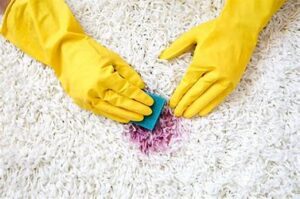
To get rid of almost all types of stains, use a combination of natural cleaning agents like vinegar, baking soda, and gentle scrubbing techniques for effective results.
A Comprehensive Guide
Stains are an inevitable part of life. Whether it’s a spilled cup of coffee, a smear of ketchup on a shirt, or a muddy footprint on the carpet, stains can be a frustrating experience. While it’s not possible to avoid them entirely, knowing how to handle various types of stains can make your life much easier. With the right techniques and products, you can remove almost any stain from clothing, upholstery, carpets, and other surfaces.
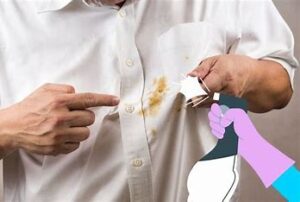
In this guide, we will explore common types of stains and how to get rid of them effectively. We’ll cover tips and tricks for dealing with everyday spills and stains, as well as offer some helpful advice for stubborn or more challenging stains.
Table of Contents
Toggle1. General Stain Removal Tips
Before diving into specific types of stains, it’s important to remember a few general rules of thumb when it comes to stain removal:
- Act Quickly: The sooner you can treat a stain, the better the chances of completely removing it. Once a stain sets in, it becomes more difficult to remove, especially if it’s allowed to dry.
- Blot, Don’t Rub: When cleaning a stain, always blot it gently with a clean cloth or paper towel. Rubbing can push the stain deeper into the fabric, making it harder to remove.
- Test Before Applying: Before using any stain removal solution, it’s always wise to test it on an inconspicuous area of the fabric or surface. This will help prevent damage or discoloration.
- Use the Right Temperature: The temperature of the water or cleaning solution is important. For example, cold water works best on blood and protein-based stains (like eggs), while hot water is effective for oily or greasy stains.
Now let’s look at some common types of stains and the best ways to get rid of them.
2. Food and Beverage Stains
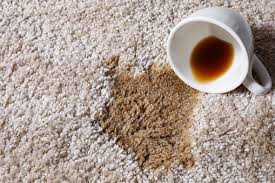
Coffee and Tea
To get rid of the various types of coffee and tea stains that can quickly make their mark on your favorite shirt or tablecloth, fortunately, they are relatively easy to remove.
- Method: Blot the stain with a paper towel or cloth to absorb as much of the liquid as possible. Then, rinse the fabric under cold water. Afterward, apply a small amount of dishwashing detergent or laundry soap directly to the stain, and let it sit for a few minutes. Launder as usual.
For persistent stains, a mixture of vinegar and water can be applied. Mix one part white vinegar to two parts water, and use a clean cloth to dab the solution onto the stain. Let it sit for about 10 minutes, then rinse and wash.
Wine Stains
Red wine stains are notorious for being tough, but they’re not impossible to get rid of.
- Method: Blot the stain with a clean cloth immediately to absorb excess liquid. Next, pour some white wine or club soda over the stain to neutralize the red wine. You can also sprinkle some salt on the stain to absorb moisture. Finally, wash the fabric with cold water, and treat the area with a stain remover if necessary.
For old or dried wine stains, apply a paste made from baking soda and water. Let it sit for a while before washing as usual.
Grease and Oil
Grease stains from food or engine oil can seem impossible to remove, but there are several effective methods to try.
- Method: First, sprinkle baby powder, cornstarch, or baking soda on the grease stain to absorb excess oil. Let it sit for a few hours, then gently scrape off the powder. Wash the fabric with hot water, and use a dishwashing detergent to break down the grease.
For stubborn stains, try using a degreaser or a specialized stain remover designed for grease.
Ketchup, Mustard, and Other Sauces
Condiments like ketchup, mustard, and barbecue sauce can leave a bright, visible stain, but they can be cleaned with some effort.
- Method: Scrape off any excess condiment without spreading it further. Soak the fabric in cold water to loosen the stain, and then apply dishwashing liquid directly to the affected area. Gently scrub the stain with a soft brush, then wash with warm water. For stubborn stains, add some white vinegar to the wash.
3. Organic Stains
Blood
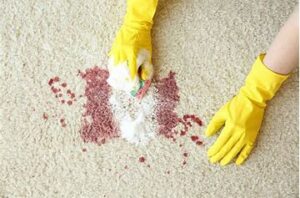
Blood stains can be challenging but are not impossible to remove, especially when treated quickly.
- Method: For fresh stains, rinse the fabric under cold water. Avoid hot water, as it can set the stain. If the stain persists, soak the fabric in a solution of cold water and salt or hydrogen peroxide. Gently scrub the area, and wash with cold water.
For older stains, enzymatic cleaners or oxygen bleach can help break down the proteins in the blood.
Sweat Stains
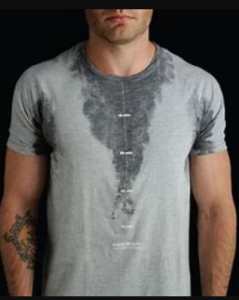
Sweat stains can leave behind yellowish marks, particularly around the underarms of shirts. These stains can be tricky but manageable.
- Method: Create a paste using baking soda and water and apply it to the stained area. Let it sit for about 30 minutes before washing with warm water and detergent. For more stubborn stains, use a vinegar solution (one part vinegar to two parts water) before washing.
Vomit
Vomit stains can be a combination of food, liquid, and acid, which can set into fabrics if not cleaned properly.
- Method: Gently blot the stain to remove any excess material. Rinse the fabric under cold water, then treat the stain with a paste of baking soda and water. Let it sit for about 30 minutes before washing with an enzyme-based laundry detergent.
4. Ink and Dye Stains
Ink stains, whether from a pen or marker, are one of the toughest stains to deal with.
- Method: Start by placing a paper towel underneath the fabric to absorb any excess ink. Dab the stain with rubbing alcohol or hand sanitizer using a clean cloth. Continue blotting until the ink starts to fade. Rinse with cold water, then launder as usual.
For stubborn stains, a specialized ink remover can be used.
Hair Dye
Hair dye stains are often permanent if not treated quickly.
- Method: Apply rubbing alcohol or a stain remover to the hair dye stain as soon as possible. Let it sit for 15-30 minutes before rinsing with cold water. If the dye is still present, repeat the process with a more concentrated solution or use a color-safe bleach.
5. Pet Stains
Urine
Pet urine stains, especially those from cats or dogs, are not only unsightly but can also leave a strong odor behind.
- Method: For fresh stains, blot the area with paper towels to absorb as much urine as possible. Afterward, clean the area with a mixture of water and vinegar (1:1 ratio). Rinse with cold water, then sprinkle baking soda to neutralize any lingering odor. Vacuum after it has dried.
For older stains, enzyme-based cleaners work best as they break down the proteins in urine, helping to remove both the stain and odor.
Vomit
Pet vomit can leave behind both stains and an unpleasant smell. The process for cleaning is similar to human vomit.
- Method: Blot up the material immediately and rinse the area with cold water. Clean the fabric with a solution of water, vinegar, and mild detergent. Rinse, and then use an enzyme-based cleaner to break down any remaining residue.
6. Mold and Mildew Stains
Mold and mildew thrive in damp, humid environments and can quickly stain fabrics and surfaces.
- Method: For fabric, mix equal parts of white vinegar and water and apply it to the stained area. Let it sit for about 30 minutes, then scrub gently with a brush. Wash the fabric with hot water.
For surfaces like tile or grout, use a mixture of hydrogen peroxide and water to clean the stains.
7. Mud and Dirt Stains
Mud stains, while messy, are easy to deal with once they have dried.
- Method: Allow the mud to dry completely, then scrape off any excess with a dull knife or spoon. Rinse the fabric under cold water to remove any remaining dirt, then apply a stain remover or liquid detergent to the area. Launder as usual.
Conclusion
Stains, while frustrating, don’t have to ruin your favorite clothes, carpets, or upholstery.
By understanding the type of stain you’re dealing with and using the right techniques and solutions, you can keep your fabrics looking fresh and clean.
To get rid of stains, it’s important to act quickly, use the appropriate cleaning techniques for the specific stain types, and test any cleaning solutions on an inconspicuous area first.
Whether you’re dealing with food stains, blood, ink, or pet accidents, most stains can be removed with a bit of effort and the right products.
By following these guidelines, you can ensure that your fabrics and surfaces remain spotless and well-maintained. Happy cleaning!

